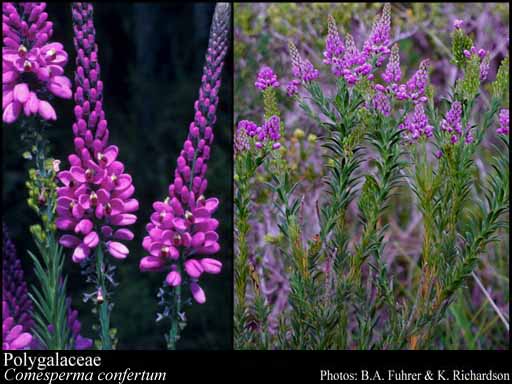- Reference
- Fl.Portug. 1:62 (1809)
- Name Status
- Current







Scientific Description
Common name. Milkwort Family.
Habit and leaf form. Trees, shrubs, and herbs, or lianas (rarely); bearing essential oils, or without essential oils. Switch-plants (sometimes), or ‘normal’ plants; sometimes with the principal photosynthesizing function transferred to stems. Autotrophic, or partially parasitic (Salomonia). When parasitic, on roots of the host. Plants with neither basal nor terminal concentrations of leaves. Self supporting, or climbing (a few). Mesophytic, or xerophytic. Leaves alternate, or opposite, or whorled; usually spiral; ‘herbaceous’, or leathery, or membranous; petiolate to subsessile; non-sheathing; gland-dotted, or not gland-dotted; simple. Leaf blades entire; pinnately veined; cross-venulate. Leaves with stipules, or without stipules. Stipules when present, intrapetiolar; free of one another; often scaly, or spiny, or represented by glands. Leaf blade margins entire. Leaves without a persistent basal meristem. Stem anatomy. Nodes unilacunar. Secondary thickening developing from a conventional cambial ring, or anomalous (commonly); commonly via concentric cambia.
Reproductive type, pollination. Fertile flowers hermaphrodite. Unisexual flowers absent. Plants hermaphrodite. Entomophilous. Pollination mechanism conspicuously specialized (via stylar modifications in the form of passive pollen presenters), or unspecialized.
Inflorescence and flower features. Flowers aggregated in ‘inflorescences’; in panicles, in racemes, and in spikes. The terminal inflorescence unit cymose. Inflorescences spikes, racemes or panicles, the pedicels often articulated. Flowers bracteate; bracteolate; small, or medium-sized; very irregular; medianly zygomorphic. The floral asymmetry involving the perianth and involving the androecium. Flowers ‘pseudo-papilionaceous’; cyclic; pentacyclic. Free hypanthium absent. Hypogynous disk present, or absent; annular (around G). Perianth with distinct calyx and corolla; 8, or 10; 2 -whorled; anisomerous (usually). Calyx 5 (the two inner members often large and petaloid); 1 -whorled; polysepalous (usually), or partially gamosepalous (the two lower members joined basally), or gamosepalous (with a short tube); imbricate; with the median member posterior. Corolla 3(–5) (declinate); 1 -whorled; gamopetalous (at the base, and adnate to the staminal tube), or polypetalous; unequal but not bilabiate (zygomorphic, the median anterior member keel-like, the upper two members free, minute or lacking). Corolla members fringed (the boat-shaped lower median, often), or entire. Androecium 8, or 10, or 3–7. Androecial members adnate (usually, to the corolla), or free of the perianth; coherent (usually), or free of one another (rarely); nearly always 1 - adelphous (the filaments usually united below into a split tube, this often adnate to the corolla); 1 -whorled, or 2 -whorled. Androecium exclusively of fertile stamens. Stamens 3–10. Anthers basifixed; dehiscing via pores, or dehiscing via short slits, or dehiscing via longitudinal slits (rarely), or dehiscing by longitudinal valves; unilocular to bilocular; bisporangiate (by reduction), or tetrasporangiate. Gynoecium 2 carpelled (usually), or 2–5 carpelled. The pistil (1–)2(–5) celled. Gynoecium syncarpous; synstylovarious to eu-syncarpous; superior. Ovary unilocular, or plurilocular; (1–)2(–5) locular. Gynoecium when G2, median; stylate. Styles 1; apical (often curved and two-lobed, one lobe stigmatic and the other with a tuft of hairs). Stigmas dry type; non-papillate; Group II type. Placentation axile. Ovules in the single cavity when unilocular, 1; when plurilocular, 1 per locule; pendulous; epitropous; with ventral raphe; arillate, or non-arillate; anatropous, or hemianatropous.
Fruit and seed features. Fruit fleshy, or non-fleshy; dehiscent, or indehiscent; a capsule, or a drupe, or a nut, or a samara. Capsules loculicidal. Seeds endospermic, or non-endospermic. Endosperm oily. Cotyledons 2. Embryo chlorophyllous (2 species of Polygala); straight. Seedling. Germination phanerocotylar, or cryptocotylar.
Physiology, biochemistry. Aluminium accumulation demonstrated, or not found. Photosynthetic pathway: C3.
Geography, cytology, number of species. World distribution: cosmopolitan, except for New Zealand, Polynesia and frigid zones. X = 5–11(+). 800 species.
Keys
Western Australian Genera and Families of Flowering Plants — an interactive key
T.D. Macfarlane, L. Watson, N.G. Marchant